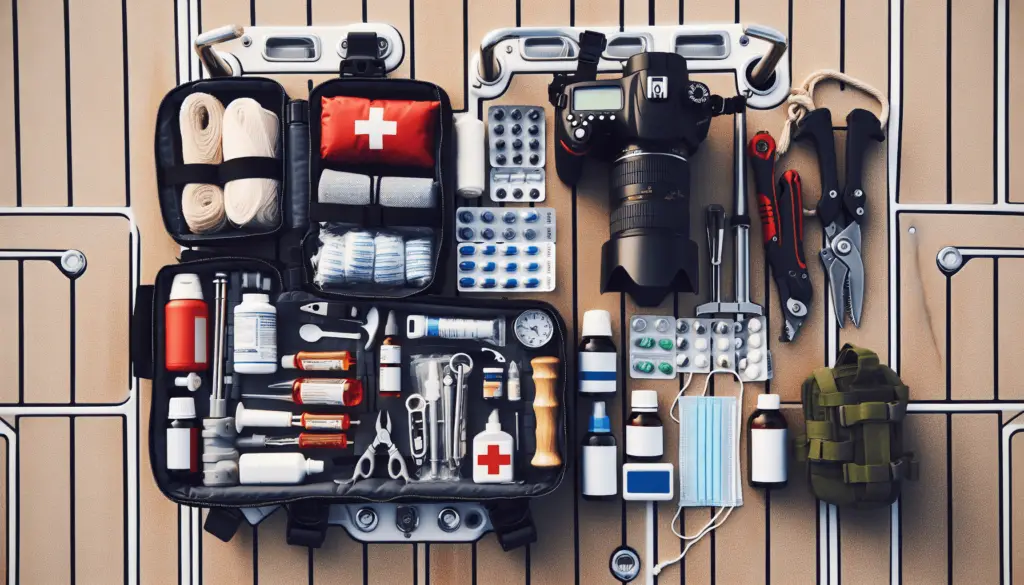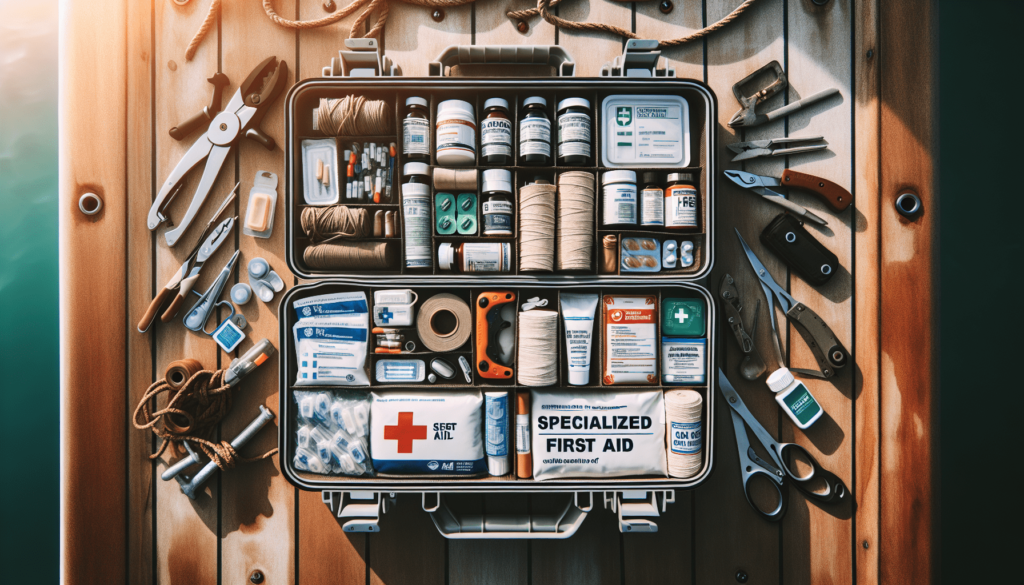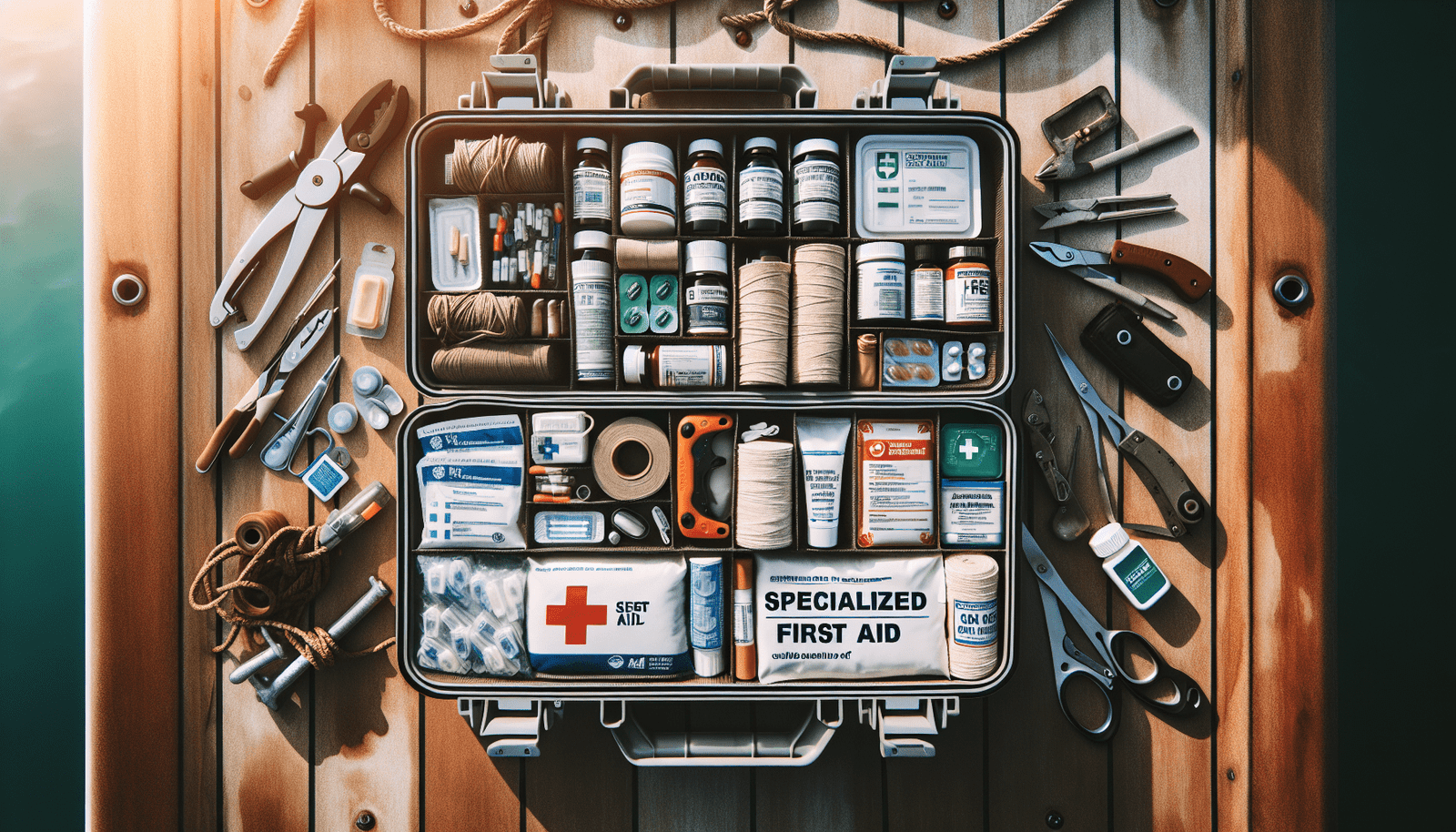Beneath the warmth of the sun and the gentle caress of the waves, you find peace as you navigate your vessel through the endless blues. In this dance with nature’s elements, safety stands paramount, which brings us to understanding the necessity of an integral piece of equipment – the “Essential First Aid Kit For Boating“. This article peels back the layers on its indispensable contents touching on the crucial tools and medicines that must grace every boater’s kit. Preparedness breeds confidence, and with this guide, you’re set to make memorable seafaring journeys, knowing you’re equipped to face any medical emergencies that might be thrown your way. Enjoy your adventure on the water, secure in the knowledge that you are ready and equipped for anything.
Importance of Having a First Aid Kit for Boating
In the realm of blue skies and open water, being equipped with a first aid kit could be the difference between a hiccup and a disaster.
Understanding the necessity of being prepared on the water
Like a magical siren, the tantalizing call of the ocean lures dozens of eager sailors and boaters, the symphony of gentle waves under the canvas of a clear sky promising an adventure to remember. However, the water remains an unpredictable and unusual environment, where even trivial injuries can escalate quickly. Hence, it is necessary to equip yourself with a reliable first aid kit for emergencies, because as you stride on the edge of civilization, help might be farther than you would expect.
Taking precautions to ensure a safe boating experience
A boating experience is like a sonnet penned by nature; always more enjoyable when your safety net is secure. Precautions you take before leaving the shore play an integral role in ensuring a safe and sound boating experience. Having a first aid kit on board is a significant part of these precautions, as it can empower you to handle minor injuries and stabilize severe medical situations till help arrives.
Significance of learning basic first aid skills before boating
While having a first aid kit is crucial, knowing how to use it is a life-saving skill. Before you embark on your aquatic adventure, familiarize yourself with basic first aid principles, such as addressing cuts and wounds, treating burns, and understanding symptoms of dehydration or seasickness. This knowledge is your safeguard against minor mishaps threatening to steal the tranquil joy from your escapade in the heart of the water.
Basic Items for a Boating First Aid Kit
A boating first aid kit is a medley of essential items skillfully compiled to provide immediate relief in case of emergencies.
Emergency numbers and boating map
Charting out the sea of care, the essential items in any first aid kit for boating ought to include emergency contact numbers and a boating map. These tools are priceless when maneuvering through the unpredictable arms of the sea.
Bandages and gauzes of different sizes
The humble bandage, a knight in a shiny armor for minor injuries like small cuts or burns. Systems of different sizes in your kit ensure that you are prepared to treat wounds, both big and small.
Antiseptic wipes or solution
So, you’ve bandaged the wound, but what about the invisible enemy, germs? That’s where antiseptic wipes or solutions come into play. They act as the vigilant samurai, eliminating any bacteria and providing a shield of cleanliness before the healing process begins.
Adhesive tape
To wrap up the wound dress-up, adhesive tape is essential to ensure bandages and gauzes hold firmly in place. Remember, a first aid kit without adhesive tape is like a book without a spine, inadequate and incomplete.

Medications to Include in Boating First Aid Kit
A medley of medications hums in the symphony of your first aid kit, each playing a vital role in situations that may arise while boating.
Antibiotics for accidental punctures or cuts
Accidental punctures or cuts while out on the water can turn into unwelcome souvenirs of your escapade, especially if they become infected. Antibiotics, fit to be the ‘guards of your health castle,’ should be a part of your first aid kit to combat this plausible situation.
Pain relievers
The melody of a boating trip could take a morose note if the pain from an injury or headache clouds your experience. Pain relievers, here, march in like a soothing lullaby, ebbing the pain and restoring your boating harmony.
Dramamine for motion sickness
If the sea’s rhythm doesn’t agree with your dance, Dramamine can save your day. A remedy for motion sickness, it can calm the chaos and reinstate your camaraderie with the sea.
Hydrocortisone cream for rashes or itchiness
The sea and sun can be a harsh combination, causing rashes and itchiness. Several strokes of hydrocortisone cream can nip these troubles in the bud, preserving the serenity of your boating narrative.
First Aid Essentials Specific for Boating
There are some essentials tailored for the unusual challenges that the marine environment poses, thereby enhancing the integrity of your boating first aid kit.
Marine tourniquet for hemorrhage control
In case of a severe accident leading to profuse bleeding, a marine tourniquet acts as a staunch defender, stemming the bleed till help arrives.
Seasickness pills
Seasickness is a common Spectre that haunts boaters. Having seasickness pills in your palette of medical aid ensures you keep the seasickness ghost at bay.
Waterproof first aid manual
When you’re out sailing the vast blue canvas, every bit of first aid knowledge counts. A waterproof first aid manual is an invaluable asset, offering practical, easy-to-understand instructions to deal with medical emergencies.
Diving masks for underwater accidents
If the boating narrative enters the underwater realm due to an accident, diving masks in your kit can be lifesavers, helping you adapt to the submerged plot change.

Useful Tools to Add in Your Boating First Aid Kit
Some tools deserve a place in your kit due to their versatility and usefulness in a variety of situations.
Scissors or shears
Scissors or shears can come into play while you’re cutting bandages, gauze, or adhesive tape. They transform the process from a challenge into a swift task.
Tweezers for splinter or fish hook removal
Tweezers can be a blessing when dealing with splinters or removing fishing hooks. In such situations, they prove to be the Heroes of precision and dexterity.
Thermometer
A thermometer, though small, plays a significant part in monitoring health conditions, notifying you if someone’s body temperature strays from the norm, and requires attention.
Safety pins
Despite their small size, safety pins can come to your aid in several situations, from securing bandages wrapped around wounds to replacing lost or broken buttons.
Importance of Personal Protective Equipment
The first interaction in every first aid operation should be personal protective equipment. Their primary goal? Ensuring your safety doesn’t get drowned while you’re playing life-saver.
The necessity of gloves for self-protection
Gloves act like aprotective barrier, shielding your hands from possible infection while treating injuries. They are a necessary addition to your protective gear.
Value of mask in providing first aid
When you’re administering first aid, a mask protects you from inhaling any potentially harmful pathogens, bolstering your health safety.
Eye protection aids
Your eyes are sensitive, and while administering first aid, they are at risk of contact with unhealthy particles. Eye protection aids guard your precious sight, ensuring your vision of the grand boating adventure remains unclouded.
Maintaining and Upgrading the First Aid Kit
Your first aid kit is a dynamic entity, requiring regular maintenance and upgrades to ensure its effectiveness in emergencies.
Regularly checking for expired medicine
Much like stale food disrupts a meal, expired medicine can disrupt your first-aid endeavors. Regular checks to replace expired or near-expiry medications maintain the freshness of your kit.
Replenishing used or missing items
To keep your kit robust, replenish any used or missing items promptly. This proactive step ensures your first aid kit remains well-stocked, ready to face any challenges the vast sea throws at you.
Evaluating the first aid kit after each boating trip
Once you’ve returned from voyaging the deep blue, evaluate your kit. Assess the effectiveness of your tools, and consider replacing or adding items depending on your experience.
Keeping Your First Aid Kit Accessible and Safe
Accessibility and safety are twin features of a reliable first aid kit. They assure you that your kit will be at your service when you require it the most.
Proper storage of the first aid kit
The storage of the first aid kit is crucial. A cool, dry area, safe from the reach of children or pets, is ideal. This keeps the equipment clean, well organized, and in perfect condition, ready for immediate use when needed.
Ensuring ease of accessibility during emergencies
While safety is crucial, your kit should be easily accessible during emergencies. Out of sight might mean out of mind, and during a crisis, every second counts. Let the location of your kit be a constant in your changeable boating adventure.
Keeping the first aid kit dry and safe
The kit’s safety from water is pivotal when you’re on water. Store it in a waterproof container to ensure the contents remain dry and usable even in the face of unexpected splashes or downpours.
First Aid Training for Boaters
The essence of a first aid kit remains incomplete without the knowledge to administer first aid. This is where training for boaters comes into the picture, adding the depth of knowledge to your tool-kits.
Importance of first aid certification courses for boaters
First aid certification courses provide the fundamentals of first aid, CPR, and emergency protocols, imparting practical skills to react effectively in emergencies. Equip yourself with this education, and you’ll add a coat of confidence to your boating excursions.
Hands-on training for specific boating accidents
Hands-on training empowers you to face boating-specific incidents with efficiency. From treating sunburns to handling hypothermia or dealing with water injuries, this training prepares you for the realm of the unforeseen.
Learning CPR and other life-saving techniques
Just like a crescendo in a symphony, CPR and other life-saving techniques form the peak of first aid training. They can help in critical situations, breathing life back into your boating narrative.
Enhancing Boating Safety Beyond First Aid Kit
While your first aid kit is the star of your safety show, there are other characters that play supporting roles in ensuring a safe boating experience.
Encouraging the use of lifejackets
Lifejackets, the protagonists of water safety, reduce the risk of drowning, maintaining the idyll in the heart of turbulent waters. Encourage the use of lifejackets, ensuring every individual on board is wearing one.
Understanding the weather conditions before setting sail
The voluble moods of the weather play a critical role in sailing. Make sure you’re tuned in to the weather forecasts, and understand conditions before setting sail, so you can incorporate safety measures accordingly.
Knowing how to call for help in case of an emergency
Lastly, know how to call for help during emergencies. Whether it’s using a VHF marine radio or signaling a nearby vessel, this knowledge can be the line between a crisis and being rescued. Always have a plan B to signal for help, should your primary method fail.
As you set sail on your boating adventure, crossing the vast expanse of water under the open skies, your first aid kit is your loyal companion, ready to step up and protect, to heal and rescue. The sea may be unpredictable, but with your first aid kit, you’re prepared for the unexpected turn in the narrative. So go ahead, embrace the boundless sea and let it whisper stories only a sailor could know!


[…] the presence of a first aid kit on board be a godsend? Thus, it becomes evident that keeping a first aid kit on your boat is truly essential, a theme this article passionately explores. It will carry you along a voyage of […]